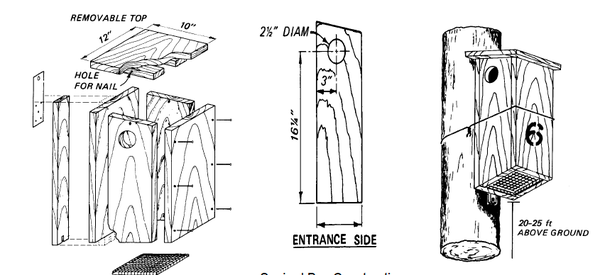Habitat Requirements
The eastern gray squirrel thrives in both urban and rural settings across North Carolina. Of the seven species of squirrels native to North Carolina, the eastern gray squirrel is the most abundant and widely distributed. It lives in a variety of forest types but favors areas with mature hardwood trees.
Mast-bearing hardwood trees are the most important element of squirrel habitat. Hard mast is any hard fruit such as acorns, beechnuts, and hickory nuts, all of which provide critical fall and winter food for squirrels. Other types of foods include flowers, buds, fleshy fruit, cones and samaras (fruit of maple trees), which are eaten when available. Squirrels also use natural cavities, in both live and dead trees, for nesting and cover.
Tips for Improving Squirrel Habitat
Mature hardwood
- Retain hardwood or mixed pine / hardwood types
- Create 10 to 40 acre stands
- Keep 1⁄3 or more of tract in 50 year or older age classes
- In pine types, create or retain hardwood patches (5 acres or more)
Mast production
- Control ground cover by mechanical methods, such as mowing
- Plant or select for mast producing trees along fences, streams, and field edges.
Direct improvements
- Erect nest boxes where cavity trees are lacking (Figure 1, Figure 2)
- Protect den trees
- Use crop tree release around hard mast trees,especially individuals known to be consistent and prolific masters (producers).
- Plant mast producing trees
Intermediate treatments
- Thin frequently, including the use of crop tree release, for larger crowns and increased nut production
- Retain mast-producing tree species in thinnings
Squirrel Box Tips
- Place dry leaves or straw on nest box floor
- Mount boxes 20 - 25 feet above ground in suitable trees. Suspend box with a nail and metal hanger attached to the back of the box
- Use a crimped wire to attach box base that can loosen as the tree grows
- Erect nest boxes in habitat where there are less than three natural dens per acre
- Construct nest boxes of decay resistant woods (cedar, cypress, etc.)
- Inspect, clear, and replace litter in the nest boxes each summer
Food
Squirrel populations fluctuate with changing yields of hard mast, especially acorns. When mast is not available, squirrels will eat other fruits and berries, flower parts, buds, bark, roots, mushrooms, and animal matter. Variety in tree species is essential for habitat stability. Listed below are some of the most common food sources throughout the year.
| Spring | Summer | Fall | Winter | |
|---|---|---|---|---|
| Acorns (red oaks) | X | X | X | |
| Acorns (white oaks) | X | X | ||
| Hickory & Beech | X | X | X | |
| Walnut | X | X | ||
| Buds & Flowers | X | X | ||
| Fleshy fruits & Berries | X | |||
| Fungi (Mushrooms) | X | X | X | |
| Yellow poplar seeds | X | X | X |
Cover
Den trees are essential to squirrels for winter shelter, escape cover from predators, and rearing of young. Natural den cavities begin to appear in 40-50 year old stands. Although leaf nests are also used, the survival rate of young is 40% lower in leaf nests compared to cavities. Frequently, squirrels will claim 2 or 3 dens at the same time. Moderate to dense cover, including midstory and canopy trees, is preferred for concealment from aerial predators suchs as hawks and owls. Dense tree cover also allows gray squirrels to move freely through the canopy. On average, about half of the den cavities identifiable from the ground are suitable for raising young. Optimal habitat has 2 to 3 suitable cavities per acre.
Water
While gray squirrels frequently use open water when available, daily needs can be satisfied from other sources such as dew and succulent plant material. Lack of surface water is not a limiting factor in squirrel habitat.
Home Range
The home range of gray squirrels varies from 1.5 to 8 acres and is usually smaller where populations are high. Populations develop social hierarchies or "pecking orders" influenced by age and sex of the animals. Dominant animals usually have larger home ranges.
Species That Benefit From Gray Squirrel Management
Numerous game and nongame species with habitat requirements similar to squirrels benefit from squirrel management. Rather than focusing on a single species, habitat management plans should emphasize the communities of which squirrels are a part. The following species are common squirrel associates:
| Songbirds | Raptors | Game species |
|---|---|---|
| Woodpeckers | Cooper's hawk | Raccoon |
| Wood thursh | Sharp-shinned hawk | Wild turkey |
| Acadian flycatcher | Red-tailed hawk | Wood duck |
| White-breasted nuthatch | Red-shouldered hawk | White-tailed deer |
| Brown-headed nuthatch | Barred owl | |
| Hooded warbler | Great horned owl | |
| Parula warbler | Screech owl | |
| Red-eyed vireo |
Working With Wildlife
North Carolina State University Extension - Forestry
Working With Wildlife Series
Publication date: Jan. 1, 2019
Reviewed/Revised: Oct. 27, 2023
NC Cooperative Extension prohíbe la discriminación por raza, color, nacionalidad, edad, sexo (incluyendo el embarazo), discapacidad, religión, orientación sexual, identidad de género, información genética, afiliación política, y estatus de veteran.
N.C. Cooperative Extension prohibits discrimination and harassment regardless of age, color, disability, family and marital status, gender identity, national origin, political beliefs, race, religion, sex (including pregnancy), sexual orientation and veteran status.




